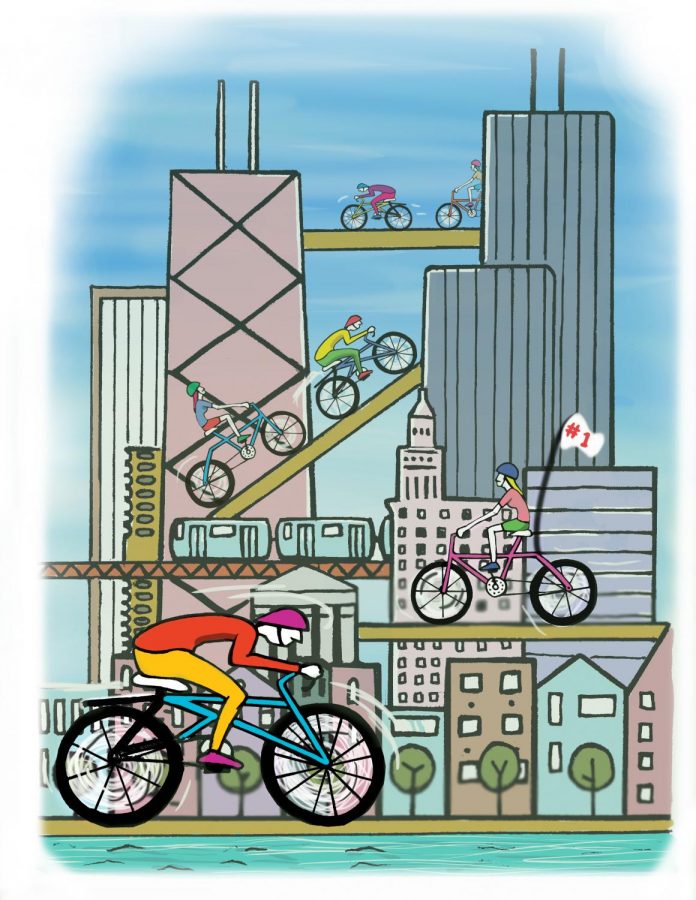Chicago overtakes competition in bicycling
Chicago overtakes competition in bicycling
October 3, 2016
Chicago zipped past New York as Bicycling Magazine’s No. 1 city in the U.S. for bikers, clinching the win with 100 miles of buffered and protected bike lanes.
The protected bike lane project, which began construction in 2015, is scheduled to be completed in the spring of 2017 in conjunction with the Loop Link Transit, a series of dedicated bus lanes that will decrease congestion downtown. Chicago will then become the first major U.S. city with a downtown network of protected bike lanes, according to Bicycling Magazine.
Tim Clinard, manager of Village Cycle Center, a bike shop in Old Town, credited Mayor Rahm Emanuel and his administration for the protected bike lane, which he uses regularly.
“It makes it easier and more accessible for new people to get onto a bike and be comfortable using it as a primary means of transportation,” Clinard said.
Naming Chicago the best city for cycling is a testament to the progress Chicago has made, said Ted Villaire, communications director at the Active Transportation Alliance, a group that promotes safe and easily accessible biking routes and programs in Chicago.
Villaire said the new bike trails are a great resource, and the 50 miles planned will increase the number of cyclists in the city.
“That new infrastructure goes a long way in enticing more people to take up biking as a way of transportation,” Villaire said.
Another reason for Chicago’s success is the Divvy For Everyone program—a new rental program sponsored by Chicago’s Department of Transportation that makes cycling affordable for low-income families in Chicago. With a variety of passes, Divvy has made cycling accessible, according to Divvy’s website.
Clinard said Divvy allows Chicagoans to ride in the city in a safe environment and enjoy the convenience of riding a bike.
“It introduces bikes to people who otherwise maybe would not have considered [bikes] as a way to get around,” Clinard said.
Villaire said cycling in Chicago has come a long way and is moving in the right direction, but there is still room for improvement and progress. He said ATA is promoting an international movement called “Vision Zero,” which aims to eliminate bicycle fatalities and serious injuries.
Villaire said “Vision Zero” is designed to prevent crashes with better infrastructure, education on biking in urban areas and enforcement of traffic laws.
While the protected lanes are good, education on how to ride a bike in the city is important, Clinard said.
“Even though you are using a bicycle, you need to be using the same judgment when you are driving a car,” Clinard said. “So, if you want to make that left turn, [put your left arm out] and let the drivers around you know what’s going on.”
Senior audio arts & acoustics major Keaton Michael said he was in two separate bicycle accidents on Damen Avenue during the week of Sept. 26, resulting in a broken arm. He attributed both incidents to lack of awareness and respect from motorists.
“We see drivers who think biking lanes belong to motorists, which is why we see cars parked in bike lanes,” Michael said.
Michael, who did not file a police report for either accident, said protected bike lanes make a huge impact because they protect drivers and allow cyclists to become more relaxed while riding. He said he would also like to see more education for people, such as bus and taxi drivers, so they are knowledgeable about sharing the streets with bicyclists.
However, Michael still encourages people to take up cycling and thinks Chicago is moving in the right direction.
“I’d recommend everyone start biking, and it’s still something I want to continue doing despite the flaws that we have,” Michael said.
The city should be proud of this accomplishment and it should be acknowledged, but there is still room for progress to make Chicago a true bike haven, Villaire said.
“We have come a long way and we’re proud of the work that has occurred, but we also have a lot of work that needs to be done,” Villaire said.
Clinard agreed and encouraged people to take the proper precautions, such as wearing a helmet and using reflective lights.
Villaire said his group, along with the city, provides education programs to better inform the community of biking in the city.
“[Current programs educate] bicyclists and motorists how to safely navigate the streets, but more efforts are needed,” Villaire said. “It’s particularly important because accidents between cars and bikes can be catastrophic.”
Divvy Bikes could not be reached for comment as of press time.








